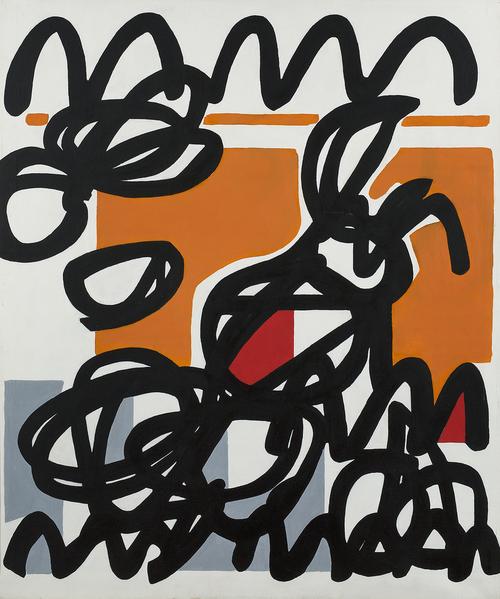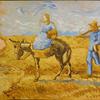RAYMOND HENDLER OPENS AT BERRY CAMPBELL
- NEW YORK, New York
- /
- March 14, 2016

Berry Campbell is pleased to announce an focused exhibition of over sixteen paintings and works on paper by Raymond Hendler (1923-1998) from the 1970s. The exhibition opens on March 17, 2016 and runs through April 16, 2016 with an opening reception on Thursday, March 17 from 6 to 8 pm.
A first-generation action painter, Raymond Hendler started his career as an Abstract Expressionist in Paris, as early as 1949. In the years that followed, he played a significant role in the movement, both in New York, where he was the youngest voting member of the New York Artist’s Club and a friend of Franz Kline, Willem de Kooning, Jackson Pollock, and Harold Rosenberg and in Philadelphia, where he ran an avant-garde gallery between 1952 and 1954.
Around 1957, his work evolved from overall tightly-wound linear webs into a personal language of abstract pictograms. Hendler continued to seek clearer lines and harder edges during the 1960s, so that by the end of the decade, he had eliminated the drag of the paint brush, commonly emphasized by the Abstract Expressionists. Remarking on Hendler’s departure from the popular Abstract Expressionist style, Kline wrote: “The direct austere design and color complexes paint the image without undue nuances—with clarity and mature independence.” 1
By the 1970s, Hendler produced some of his most important work. Using open, white spaces, Hendler created intelligible symbols scattered cheerfully across the flat picture plane. These jubilant marks on their fresh white grounds animate the canvas often appearing as if they were flowing hieroglyphs or animated handwriting. The artist called these artistic scrawls “graffiti” before the style became popular as an art form. Hendler continued, “Writing is a kind of self-revelation that gives you a chance to become. It acts as a catalyst. It does all a line can do in terms of noting and connoting.”2
Hendler’s new style would foreshadow many of the movements that became popular in the later half of the twentieth century: the lighthearted pop art of the 1960s, the reductive minimalism of the late 1960s and 1970s, neo-expressionism of the late 1970s and 1980s, and text based art of the 1980s. In addition, his animated compositions predated his fellow Abstract Expressionist and friend, Philip Guston’s return to figuration in the late 1960s.
Hendler differed from Rosenberg’s belief that American post-war painting should have a clear break from the past. His work often recalls the autonomism and nonobjectivism of his European predecessors. However, Stuart Preston noted in The New York Times that Hendler had a “totally different approach to nonobjectivism. . . . He excels in bright hard explicit pattern-making, in straightforward parades of independent shapes, not unlike those in Matisse’s collages. There is something reminding of Leger here as well, particularly in the unambiguous glare of contrasted color and in the robust refusal to allow shapes to suggest anything beyond their merry self.”3 Hendler was represented by Rose Fried Gallery, one of the most important galleries of its time and a champion of many Euro-pean artists, including Marcel Duchamp, Juan Gris, Vasily Kandinsky, Joan Miro, and Piet Mondrian.
Although images are at times visible, Hendler always maintained that his work was non-representational. Instead, the images serve to convey his vitality and child-like sense of wonder in a highly sophisticated order. In a review for The New York Times, Helen Harrison wrote that the “schematic character. . . exploits the crispness of acrylic without sacrificing painterly energy.”4 Jane Gollin said, “his cheerful style never succumbs to mere visual intoxication . . . traffic is patiently, wittily controlled in paintings that are simultaneously cerebral and sensuous.”5
Raymond Hendler was born in Philadelphia, Pennsylvania in 1923 and studied in his native Philadelphia, at the Graphic Sketch Club, the Philadelphia College of Art, the Pennsylvania Academy of Art, and the Tyler School of Art (Temple University). In 1949, he continued his art training in Paris at the Académie de la Grande Chaumière on the G.I. Bill. Immersing himself in the Left Bank art scene, he formed close friendships with the Canadian Taschist painter, Jean Paul Riopelle, and the noted Australian sculptor, Robert Klippel. In Paris, he exhibited at the Musée d’Art Moderne and was a founding member of Galerie Huit, the first American cooperative gallery in Europe. Its members included Sam Francis, Al Held, Shirley Jaffe, Jules Olitski, among others.
Returning to New York in 1951, Hendler became part of the exploding Greenwich Village art scene. He was a voting member of the New York Artist’s Club from 1951 until its end in 1957. He was a friend of the leading figures in the New York School, including the painters Pollock, de Kooning, and Philip Guston and the critic Harold Rosenberg. With Franz Kline, he established a friend-ship that would last throughout the rest of Kline’s life. During this same period, Hendler was active in Philadelphia. At the Hendler Galleries, which he ran from 1952 to 1954, he exhibited the work of de Kooning, Sam Francis, Guston, Kline, George McNeil, Stephen Pace, Pollock, Milton Resnick, Riopelle, Ludwig Sander, and Jack Tworkov.
Hendler had frequent solo and group exhibitions in New York, Philadelphia, Minneapolis, and other locations. He was represented by the Rose Fried Gallery during the 1960s and had a series of solo exhibitions until her death in 1970. In 1963, he received the Longview Foundation Purchase Award, juried by de Kooning, Thomas Hess, Guston, Rosenberg, and David Smith. Since his death in 1998, his work has continued to be featured in solo and group shows, many of which are important reconsiderations of the art of the second half of the twentieth century.
During his forty-year teaching career, Hendler also taught at the Contemporary School of Art, Brooklyn; Parsons School of Design, New York; Pratt Institute, Brooklyn; and School of Visual Arts, New York; and Minneapolis College of Art, where he was head of the painting department. Hendler retired from teaching in 1984 and moved two years later to the East End of Long Island. He lived and painted for the last ten years of his life in the house in East Hampton’s Northwest Woods that he built with his wife, Mary Rood.
Hendler is represented in the collections of numerous museums and public collections in America and abroad, including Birla Academy of Art & Culture, Calcutta, India; Frederick R. Weisman Art Museum, Minneapolis; Grey Art Gallery, New York University; J. Walter Thompson Company, New York; Minneapolis College of Art & Design; Minneapolis Institute of Art; Novartis Co., East Hanover, New Jersey; Philadelphia Museum of Art; Pennsylvania Academy of the Fine Arts, Philadelphia; University of New Mexico, Art Museum, Albuquerque; University of Notre Dame, Indiana; and Walker Art Center, Minneapolis.
- Franz Kline, Raymond Hendler (catalogue for an exhibition at Rose Fried Gallery), 1962.
- Gordon Brown, “Interview with Raymond Hendler,” Arts Magazine, 1967.
- Stuart Preston, “Art: Abstractionist Seeks Nature’s Aid,” New York Times, January 20, 1962.
- Helen Harrison, “Avant Garde,” New York Times, October 22, 2000.
5. Jane Gollin, “Art Review: Raymond Hendler,” Pictures on Exhibit, 1962.
Contact:
Christine Berry Martha CampbellBerry Campbell
212-924-2178
info@berrycampbell.com
530 W 24 Street
New York, New York
info@berrycampbell.com
212-924-2178
http://www.berrycampbell.com
About Berry Campbell LLC
BERRY CAMPBELL features Post-War Modern and Contemporary art with a focus on established as well as emerging and mid-career contemporary artists, including Edward Avedisian, Walter Darby Bannard, Eric Dever, Ken Greenleaf, Raymond Hendler, Jodie Manasevit, William Perehudoff, and Ann Purcell. BERRY CAMPBELL is a collaboration between Christine Berry and Martha Campbell. Christine Berry began her career at the Modern Art Museum of Fort Worth and then continued onto the Whitney Museum of American Art. Thirteen years ago, she shifted from the non-profit sector to the commercial world. As an art dealer, she worked with some of the world’s foremost public and private collections. Martha Campbell started her career at The Phillips Collection in Washington, DC. She was the director at a major midtown gallery focusing on Modern and Contemporary art. Christine Berry cb@berrycampbell.com Martha Campbell mc@berrycampbell.com Devi Loftus Gallery Assistant devi@berrycampbell.com





100x100_c.jpg)

5100x100_c.jpg)







